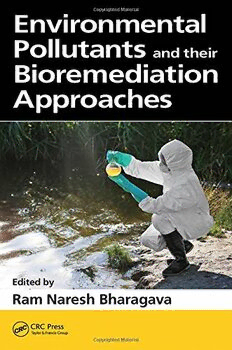
Environmental Pollutants and Their Bioremediation Approaches PDF
Preview Environmental Pollutants and Their Bioremediation Approaches
ENVIRONMENTAL POLLUTANTS AND THEIR BIOREMEDIATION APPROACHES ENVIRONMENTAL POLLUTANTS AND THEIR BIOREMEDIATION APPROACHES Edited by Ram Naresh Bharagava CRCPress Taylor&FrancisGroup 6000BrokenSoundParkwayNW,Suite300 BocaRaton,FL33487-2742 ©2017byTaylor&FrancisGroup,LLC CRCPressisanimprintofTaylor&FrancisGroup,anInformabusiness NoclaimtooriginalU.S.Governmentworks Printedonacid-freepaper InternationalStandardBookNumber-13:978-1-138-62889-2(Hardback) This book contains information obtained from authentic and highly regarded sources. Reasonable effortshavebeenmadetopublishreliabledataandinformation,buttheauthorandpublishercannot assumeresponsibilityforthevalidityofallmaterialsortheconsequencesoftheiruse.Theauthors andpublishershaveattemptedtotracethecopyrightholdersofallmaterialreproducedinthispublica- tionandapologizetocopyrightholdersifpermissiontopublishinthisformhasnotbeenobtained.If anycopyrightmaterialhasnotbeenacknowledgedpleasewriteandletusknowsowemayrectifyinany futurereprint. ExceptaspermittedunderU.S.CopyrightLaw,nopartofthisbookmaybereprinted,reproduced, transmitted,orutilizedinanyformbyanyelectronic,mechanical,orothermeans,nowknownorhere- afterinvented,includingphotocopying,microfilming,andrecording,orinanyinformationstorageor retrievalsystem,withoutwrittenpermissionfromthepublishers. For permission to photocopy or use material electronically from this work, please access www. copyright.com (http://www.copyright.com/) or contact the Copyright Clearance Center, Inc. (CCC),222RosewoodDrive,Danvers,MA01923,978-750-8400.CCCisanot-for-profitorganiza- tionthatprovideslicensesandregistrationforavarietyofusers.Fororganizationsthathavebeen grantedaphotocopylicensebytheCCC,aseparatesystemofpaymenthasbeenarranged. TrademarkNotice:Productorcorporatenamesmaybetrademarksorregisteredtrademarks,andare usedonlyforidentificationandexplanationwithoutintenttoinfringe. LibraryofCongressCataloging-in-PublicationData Names:Bharagava,RamNaresh,editor. Title:Environmentalpollutantsandtheirbioremediationapproaches/editor, RamNareshBharagava. Description:BocaRaton:Taylor&Francis,CRCPress,2017.|Includesbibliographical references. Identifiers:LCCN2016057862|ISBN9781138628892(hardback:alk.paper) Subjects:LCSH:Bioremediation. Classification:LCCTD192.5.E95652017|DDC628.5--dc23 LCrecordavailableathttps://lccn.loc.gov/2016057862 VisittheTaylor&FrancisWebsiteat http://www.taylorandfrancis.com andtheCRCPressWebsiteat http://www.crcpress.com Contents Preface......................................................................................................................vii Editor.........................................................................................................................ix Contributors..............................................................................................................xi Chapter1 Bioremediation:AnEco-SustainableGreenTechnology:Its ApplicationsandLimitations...............................................................1 RamNareshBharagava,PankajChowdhary,andGauravSaxena Chapter2 OrganicandInorganicPollutantsinIndustrialWastes: EcotoxicologicalEffects,HealthHazards,and BioremediationApproaches...............................................................23 GauravSaxenaandRamNareshBharagava Chapter3 PesticidesContaminationintheEnvironment:Toxicological Effects,andBiodegradationandBioremediationMechanisms forEnvironmentalSafety...................................................................57 NamasivayamVasudevanandOdukkathilGreeshma Chapter4 UraniumRadionuclideContaminationintheEnvironment: EcotoxicologicalEffects,HealthHazards,and Bioremediation.................................................................................103 MeenakshiNandalandMansiRastogi Chapter5 DyesContaminationintheEnvironment:Ecotoxicological Effects,HealthHazards,andBiodegradationandBioremediation MechanismsforEnvironmentalCleanup.........................................127 UmaShankarPrasadUday,NibeditaMahata, SoumyaSasmal,TarunKantiBandyopadhyay, AbhijitMondal,andBiswanathBhunia Chapter6 LindaneContaminationintheEnvironment:Toxicological EffectsandBioremediationApproaches..........................................177 SiddharthBoudhandJayShankarSingh v vi Contents Chapter7 ToxicMetalsContaminationintheEnvironment: ToxicologicalEffectsandBioremediationApproaches forEnvironmentalCleanup............................................................209 JanardhanReddyKoduru,ShivShankar,NandkishorS.More, Shikha,LakshmiPrasannaLingamdinne,andJiwanSingh Chapter8 BioremediationofNonaqueousPhaseLiquids(NAPLs)- PollutedSoil-WaterResources.......................................................241 PankajKumarGuptaandBrijeshKumarYadav Chapter9 MicrobialStrategiesforEnhancedPhytoremediationofHeavy Metal-ContaminatedSoils..............................................................257 JyotiSinghandAjayVeerSingh Chapter10 MicrobialCellulasesandTheirApplicationsinthePulpand PaperIndustry:AnEmergingParadigm........................................273 ShivShankar,M.Gupta,andShikha Chapter11 Phytoremediation:AGreenTechnologyforRemediationof Metal-ContaminatedSites..............................................................305 ManojKumarandRajeshSingh Chapter12 SolidWaste:EnvironmentalThreatsandManagement.................337 V.SudharsanVarmaandAjayS.Kalamdhad Chapter13 PollutantsinTanneryWastewater:Pharmacological Effects,andBioremediationApproachesforHumanHealth ProtectionandEnvironmentalSafety.............................................369 SwetlanaGautam,GauravKaithwas,RamNaresh Bharagava,andGauravSaxena Chapter14 ConstructedWetlands:AnEmergingPhytotechnologyfor DegradationandDetoxificationofIndustrialWastewaters...........397 RamNareshBharagava,GauravSaxena,andPankajChowdhary Chapter15 BiomedicalWastes:EnvironmentalThreats andManagement............................................................................427 SaharMohamedSolimanandAmelIbrahimAhmed Index......................................................................................................................443 Preface The contamination of environments (soil/water/air) with toxic environmental pollu- tantsreleasedfromvarioussources,theirecotoxicologicaleffects,andhealthhazards isaseriousconcernworldwide.Thedegradationanddetoxificationoftoxicenviron- mental pollutants for environmental safety are global challenges. The wastes/pollu- tants released from various natural and anthropogenic sources are widespread in mostofthecountries,causingeitherthedirectpollutioninsoilandaquaticresources orindirectpollutionofthesurfacewaterandgroundwater.Governmentsaroundthe globe are strictly advocating for the mitigation of environmental pollution. Hence, the removal/elimination of toxic pollutants from contaminated environments is of utmost importance to promote the sustainable development of our society with low environmental impact. Conventional remediation technologies are expensive,envir- onmentallydestructive,andnotaestheticallypleasing.Inthisregard,bioremediation hasrecentlyemergedasan“eco-friendly”and“cost-effective”sustainablealternative forenvironmentalcleanup. Bioremediation is an environment-friendly and cost-effective approach, which uses microbes such as bacterial/fungi/algae/yeast/cyanobacteria etc., green plants, or their enzymes, to degrade/detoxify toxic environmental pollutants from polluted soilsandwaterresources.Thus,detailedknowledgeofthevarioustypesofenviron- mentalpollutants,theirtoxicologicaleffectsinenvironments,inhumans,inanimals, and in plants as well as various bioremediation approaches for their degradation/ detoxification are urgently required for environmental cleanup and safety of human and animals. However, the degradation and detoxification potential of microbes and their interactions with environmental pollutants has been studied in past few years, but detailed knowledge of the various types of environmental pollutants, theirtoxicologicaleffectsinenvironments, humans,andanimals,aswellasvarious bioremediation approaches used for their degradation/detoxification is scanty and notavailableasacollection. This book will provide detailed, comprehensive knowledge of various types of toxicenvironmentalpollutants,suchastoxicmetals,pesticides,azodyes,petroleum hydrocarbons,plasticswastes,phenols,chlorophenols,etc.,dischargedfromnatural aswellasanthropogenicsources;theirtoxicologicaleffectsinenvironments,humans, and animals; and their biodegradation and bioremediation through microbes/plants and/orbytheirenzymesaswellasbyconstructedwetlandtreatmentapproachesfor environmentalcleanup.Anumberofexpertsfromcolleges,universities,andresearch laboratories have contributed their valuable knowledge for this book in the areas of biodegradationandbioremediationofenvironmentalpollutants. Thisbook will also serve as aninvaluable source of basic knowledge andrecent advances in biodegradation and bioremediation of toxic environmental pollutants thatwidenitsscopeforadiversecommunityofprofessionalshavinginterestsinbior- emediation technologies. All the chapters compiled in this book cover different aspectsofenvironmentalproblemsandtheirremedieswithup-to-datedevelopments inthefieldofbiodegradationandbioremediation.Thisbookwillbeofgreatvalueto vii viii Preface researchers,environmentalchemistsandscientists,microbiologistsandbiotechnolo- gists, eco-toxicologists, waste treatment engineers and managers, environmental science managers, administrators and policy makers, industry persons, and students at bachelor’s, master’s, and doctoral level in the relevant field. At last, I sincerely extendmyheartfeltthankstoalltheleadingexpertsforcontributingvaluablechapters tothisbookandtomyresearchscholarMr.GauravSaxenaforhelpingmeinvarious waysduringthisbookproject.Thus,inthisbook,readerswillfindtheupdatedinfor- mationaswellasthefuturedirectionforresearchinthefieldofbiodegradationand bioremediationofenvironmentalpollutants. RamNareshBharagava BabasahebBhimraoAmbedkarCentralUniversity Lucknow,UttarPradesh,India Editor Dr.RamNareshBharagavawasbornin1977andcompleted his education in Government Schools at Lakhimpur Kheri, India. He received a BSc degree (1998) in zoology, botany, and chemistry from the University of Lucknow, India, and an MSc degree (2004) in molecular biology and biotechnology from Govind Ballabh Pant University of Agriculture and Technology (GBPUAT), Pantnagar, India. He received a PhD (2010)intheareaofmicrobiologyjointlyfromtheenvironmen- talmicrobiologydivision,IndianInstituteofToxicologyResearch(IITR)Councilof Scientific and Industrial Research (CSIR), Lucknow, India, and Pt. Ravishankar Shukla University, Raipur, India. He was the Junior Research Fellow (JRF) during his PhD, qualified twice (2002 & 2003) on the CSIR-National Eligibility Test (NET) and Graduate Aptitude Test in Engineering (GATE) in 2003. His major research work during his PhD focused on the bacterial degradation of recalcitrant melanoidin from distillery wastewater. He has authored one book and edited two books. He has also written many chapters for national and international books. He has published many popular science articles in national newspapers, and national and international magazines. Dr. Bharagava has presented many research papers relevant to his research areas in national and international conferences. He has also served as a potential reviewer for various national and international journals in his respective areas of the research. Dr. Bharagava was awarded a postdoctoral appointment at CSIR-IITR, Lucknow, India, but left and subsequently joined (2011) Babasaheb Bhimrao Ambedkar (Central) University, Lucknow, India. He is currently working as an assistant professor of environmental microbiology and activelyengagedinteachingatthepostgraduateanddoctorallevelsandconducting research on the various Government of India (GOI)–sponsored projects in the area of environmental toxicology and bioremediation at Laboratory for Bioremediation and Metagenomics Research (LBMR) under the Department of Environmental Microbiology (DEM). His research has been supported by the University Grants Commission (UGC) and Department of Science and Technology (DST), India. He hasbeentheadvisortomorethan40postgraduatestudentsandcurrently,thementor of 1 project fellow and 6 doctoral students. His major areas of research include the environmental toxicology, biodegradation, and bioremediation of environmental pollutants/industrial wastewaters, metagenomics, and wastewater microbiology. He is a life member of the Academy of Environmental Biology (AEB), Association of Microbiologists of India (AMI), and Biotech Research Society, India (BRSI), ix
